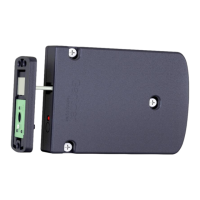
Do you have a question about the Gantner GAT ECO.Side Lock 7000 BA and is the answer not in the manual?
| Category | Locks |
|---|---|
| Type | Electronic Lock |
| Model | GAT ECO.Side Lock 7000 BA |
| Brand | Gantner |
| Security Level | High |
| Installation | Surface Mount |
| Power Supply | Battery Operated |
| Communication | RFID |
| Compatibility | Access Control Systems |
Explains the structure and meaning of safety messages and symbols used in the manual.
Details personal safety messages, including signal words and their meaning.
Defines signal words like CAUTION and NOTICE used for property damage warnings.
Explains various safety symbols and their corresponding meanings for user guidance.
Provides FCC compliance information, warnings, and statements for US users.
Details Industry Canada compliance information and ICES statements.
Provides an overview of the manual's content and the GAT ECO.Side Lock 7000 BA.
Outlines the content of each chapter in the manual for easy navigation.
Provides contact information for questions and inquiries regarding the product.
Identifies the intended audience for the manual, including technicians and end-users.
Explains the formatting conventions used in the manual for clarity and consistency.
Describes the primary applications and purpose of the GAT ECO.Side Lock 7000 BA electronic lock.
Explains how the GAT ECO.Side Lock 7000 BA operates, including locking and unlocking mechanisms.
Defines key terms and acronyms used throughout the manual for better understanding.
Explains the RFID technology used by the lock and supported data carrier types.
Lists and illustrates all the components included in the GAT ECO.Side Lock 7000 system.
Specifies the target audience for the installation chapter, requiring technical skills.
Explains how to identify right-handed and left-handed doors for correct installation.
Outlines the procedure for performing a test installation before mass deployment.
Discusses considerations for installing the lock on different door materials.
Introduces the bolt gauge tool and its use in marking drill hole positions.
Describes the door status contact and its importance for lock functionality.
Provides guidelines to prevent battery drain during transportation.
Specifies procedures for replacing the lock after a security breach.
Provides essential measurement diagrams for correct lock installation.
Details the installation process for non-metallic doors, excluding glass.
Lists key requirements before installing the lock on non-metallic doors.
Provides step-by-step instructions for installing the lock on non-metallic doors.
Guides the installation process for metallic locker doors, including cutouts.
Details the specific cutouts required in metallic doors for mounting components.
Lists prerequisite conditions for installing the lock on metallic doors.
Provides step-by-step instructions for installing the lock on metallic doors.
Covers the specific installation procedures for glass locker doors.
Outlines the necessary requirements before installing the lock on glass doors.
Details the step-by-step instructions for installing the lock on glass doors.
Identifies the technicians responsible for commissioning the lock.
Details battery types, installation, replacement, and lifespan for the lock.
Explains how to connect the lock to a PC/laptop for configuration via USB.
Describes the process for calibrating the lock's antenna for optimal RFID reading.
Provides an overview of the configuration process using GAT Config Manager.
Guides users through setting up the GAT Config Manager software for lock configuration.
Details how to access, view, and modify lock configuration parameters.
Explains the process of applying configured settings to the lock.
Covers procedures for updating the lock's firmware to the latest version.
Details the different operating modes available for the lock.
Explains how to define and assign a unique number to each locker.
Describes how to enable or disable the audible beeper for lock activity.
Explains how to activate or deactivate the lock's alarm function.
Covers the function to automatically unlock the locker at a specific time.
Details how to set usage time limits for lockers in free locker mode.
Explains the feature to automatically lock personal lockers when the door is shut.
Describes how to assign MASTER data carriers for special access or emergency openings.
Lists all available configuration options, their descriptions, formats, and default values.
Provides an overview of the lock's operating modes: free locker and personal locker.
Identifies the target audience for the operation chapter.
Lists and describes the different operating modes of the GAT ECO.Side Lock 7000 BA.
Details the free locker mode and its duration of use feature.
Explains the free locker universal mode and its requirements for data carriers.
Describes the free locker mode where any data carrier can lock any number of lockers.
Details how to authorize data carriers for personal lockers using a program card.
Explains how to remove authorized data carriers from a personal locker.
Describes the mode where lockers are assigned with an expiry date for data carriers.
Explains the function and usage of MASTER data carriers for unlocking lockers.
Describes the OPEN MASTER data carrier for unlocking lockers only.
Details how to delete stored MASTER data carriers from the lock.
Explains the use of the PROGRAM data carrier for authorizing personal lockers.
Describes the BATTERY data carrier used to reset the lock after battery replacement.
Explains the function of the SERVICE data carrier for configuration and calibration.
Covers how to handle and deactivate the lock's alarm.
Provides a summary of LED and beep signals indicating lock status.
Identifies personnel responsible for cleaning and maintenance.
Details procedures for periodically testing lock functionality and components.
Provides instructions for cleaning the lock components safely.
Clarifies that the lock is maintenance-free, but parts may need replacement.
Lists technical specifications for the battery and power supply.
Details specifications for the RFID reader, data carriers, and reading range.
Outlines specifications for data storage and the internal clock.
Describes the physical control and display components of the lock.
Lists the interface types and connections available for the lock.
Provides technical details about the lock's housing material, dimensions, and weight.
Specifies the permitted operating temperature, protection types, and compliance standards.